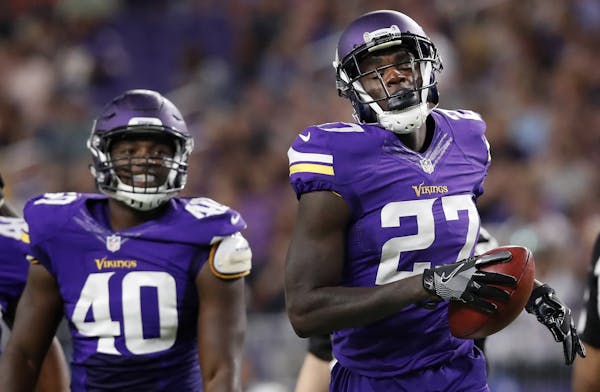Believe it or not, Sam Bradford is a read-option quarterback here in Minnesota.
Bradford was a multisport star growing up in Oklahoma, standing out among his peers in basketball, hockey and, well, you name it. But Bradford, who has had his left knee surgically repaired twice, is not known as a runner in the NFL.
Instead, the Vikings ask him to execute plays with a run-or-pass option, also known as packaged plays, to rely on his brain, not his legs, to put defenses in a bind.
"Those, to me, are what you can do with guys that aren't necessarily runners because he's either handing off or throwing a quick pass," said Scott Turner, the Vikings quarterback coach and son of Norv Turner, the offensive coordinator.
Midway through the first quarter of the Week 4 win over the New York Giants, the Vikings faced first-and-10 in Giants territory. They lined up three wide receivers on Bradford's right with running back Jerick McKinnon beside him in the backfield. On this play, he could either hand off to McKinnon or whip the ball out wide.
Standing in the shotgun and scanning the defense, Bradford counted two Giants defensive backs to his right. With a 3-to-2 numbers advantage, his pre-snap read was an easy one — throw the quick bubble screen to Cordarrelle Patterson.
With his two fellow wide receivers tying up a pair of Giants defenders, Patterson nearly broke loose for a 41-yard touchdown but was tackled for a 21-yard gain.
"It's a way to make the defense cover the whole field," Scott Turner said. "You stretch them out horizontally … and if you get a look, you throw it out there. If you don't get the look, you're running the run. It's really a numbers game."
The Vikings are one of many NFL teams that are using run-pass options, or RPOs in coachspeak, to use those numbers to their advantage. While they are much more common in the wide-open spread attacks in the college ranks, Scott Turner guessed that every NFL offense is now using run-pass option plays in some capacity.
The Vikings had them in the playbook the past two years with Teddy Bridgewater behind center. And while he said the frequency has not changed with Bradford, Scott Turner said Bradford is comfortable running them from his time in Philadelphia, when Chip Kelly was his coach and Pat Shurmur his offensive coordinator.
"You want to have the flexibility to attack a defense, and that's one thing I'll tell you with Sam — we've given him a lot because he can handle it," Norv Turner said.
Scott Turner, who didn't want to divulge too many details to the Chicago Bears and other future opponents, estimated that on about 85 percent of RPO plays at the NFL level, the QB decides where the ball is going before the snap.
"It just depends on the look that you're getting," Bradford explained. "Sometimes, if they line up in it, then you know what you're looking at pre-snap. But if you get a late rotation or a late pressure, then it's something you have to see on the [fly]."
When that decision is made post-snap, the quarterback typically reads one defender after the snap and reacts to his movement, similar to mobile QBs on read-option runs. But instead of eyeing an edge defender on the line of scrimmage, the quarterback on RPOs usually reads an off-the-ball linebacker or safety.
If that defender runs forward to attack the run when a quarterback puts the ball in the running back's belly, the QB pulls the ball and looks for an open receiver in the space the defender just vacated. If the defender stays put, he hands it off.
"They put you in a run-pass conflict," outside linebacker Chad Greenway said. "Do you come up out of coverage and run toward the [ball carrier] or do you sit back in coverage and then they run? It's a natural conflict that happens in football."
And, if executed properly by the offense, that defender is wrong no matter what he does.
The Green Bay Packers, for example, are a team that has had success with these plays, with quarterback Aaron Rodgers either giving the ball to Eddie Lacy for a run between the tackles or tossing a quick slant to slot receiver Randall Cobb.
The Vikings, having seen RPOs create an advantage at both the pro and college levels, have sprinkled them into their game plans, along with wildcat option runs that put McKinnon at quarterback and Patterson next to him in the backfield.
"Every offseason, you look at what other people are doing to be successful," Scott Turner said. "We spend a lot of time evaluating college players, so when you look at college film, you see a play and say, 'Wow, that might be something we want to try.' Some stuff sticks and other stuff you realize isn't going to work."
Scott Turner believes that read-option elements, whether they are run-run options or run-pass, will remain a staple in NFL offenses. But despite their effectiveness, he was hesitant to say they will become built into every play.
"I don't know. Everything goes in cycles. The game changes and then it comes back to where it was before," Turner said. "I don't think the NFL is going to turn into the Big 12. But I do think that some teams are looking to spread people out and [RPOs are one of many] different ways to move the football and score points."

